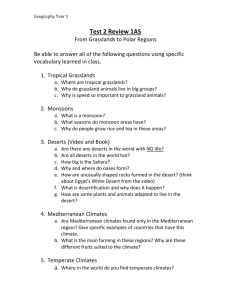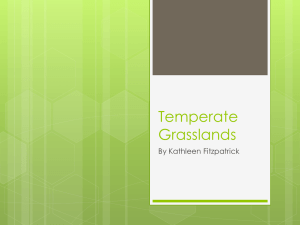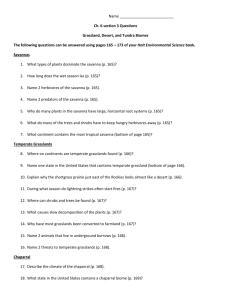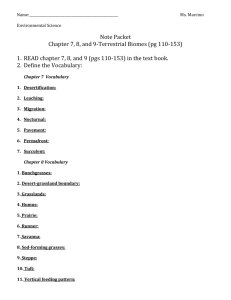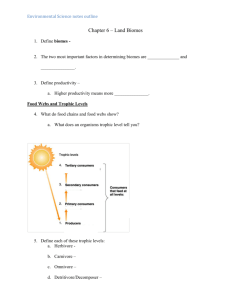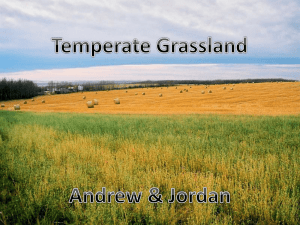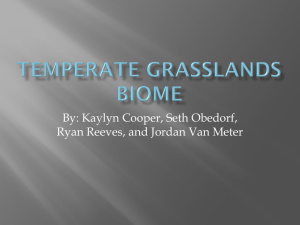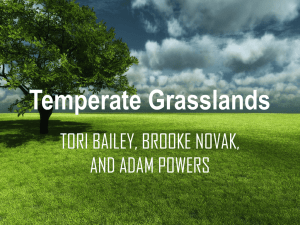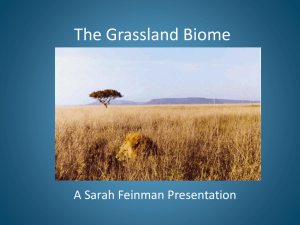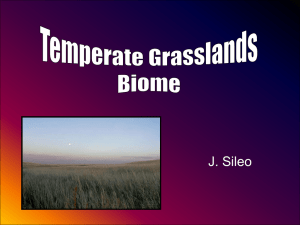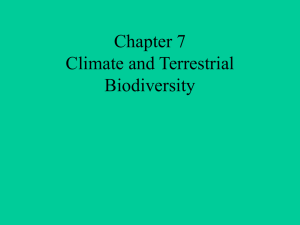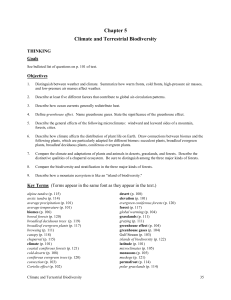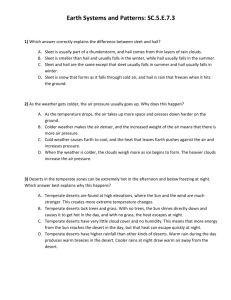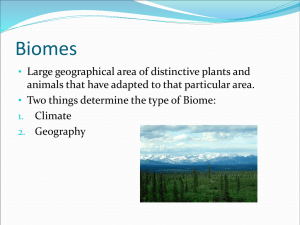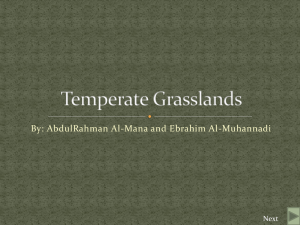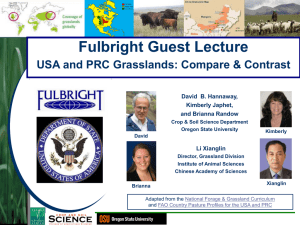Biomes - Deserts and Grasslands
advertisement
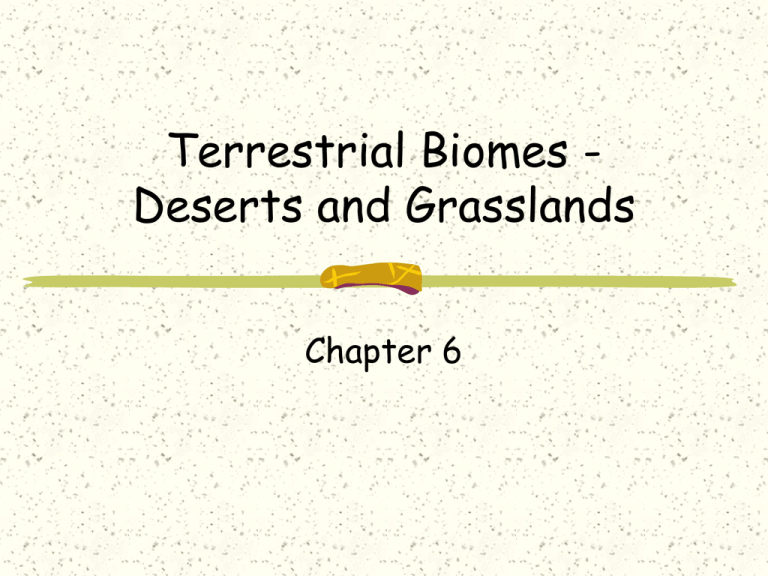
Terrestrial Biomes Deserts and Grasslands Chapter 6 What is a biome? Biome – a major ecological community type Tropical rainforest Temperate forest Grassland Desert Tundra Taiga Climate Climate: “a region’s weather condition patterns over a long period of time” what causes one biome to develop rather than another Main abiotic factors that determine climate are precipitation and temperature. Temperature and Precipitation Controlled by: Air circulation Uneven heating of the earth’s surface Seasonal changes Earth’s rotation Interrelated properties of air and water Uneven heating of water and land Air Circulation Patterns Tundra Temperature and Precipitation Controlled by: Water circulation (ocean currents) All the properties that affect air circulation also affects water circulation plus: Water density Redistribution of heat World’s Ocean Currents Terrestrial Biomes All biomes of the same name have: similar physical characteristics similar ecological communities Communities may have adaptations specific to their climate. Climate Characteristics Climate characteristics are determined by: Wind patterns Ocean Currents Latitude Altitude Biomes are not uniform because of microclimates. Microclimates Local climate conditions that are different than the overall climate of a particular region Some microclimates can be extremely large Rainshadow effect Rainshadow Effect Deserts of the World Deserts - Facts “An area where evaporation exceeds precipitation” Make up about 30% of earth’s land surface Most are found between 30ON and 30OS latitude Deserts - Facts Experience a large daily temperature range Precipitation is <10” per year Soils are hard, dry and sandy with few nutrients Many desert organisms rely on oases and fog for moisture Desert There are three categories of desert based on: temperature range amount of precipitation vegetation/animal species Tropical deserts Driest places on earth (<5” rain/year) Temperate deserts Sometimes caused by rainshadow effect Cold deserts Also called interior deserts Desert Plants Called xerophytes Adaptations: Require few nutrients Require little water Leaves are small, thick and waxy or have become spines Can expand to hold extra water Desert Animals Adaptations Usually nocturnal Usually small Hard shells or thick skins Poisonous Hibernate or enter suspended animation during droughts Can conserve water Human Impacts on Deserts 1. Urbanization 2. Agriculture 3. Depletion of groundwater Pollution and general damage Use of remote areas for specialized purposes So What???? Extremely fragile ecosystems Take a long time to recover from damage because of: Slow nutrient cycling Slow plant growth Low species diversity Water shortage Grasslands Region with enough annual precipitation to support grass (some small trees) Most are found in interiors of continents Usually on leeward side of mountain ranges Precipitation is erratic Wildfires are common Grasslands Trees and shrubs cannot ‘take over’ grasslands because: Seasonal drought Grazing by large herbivores Periodic wildfires There are 3 major types of grassland. Grassland type depends on temperature and precipitation. Tropical Grassland Also called savanna Cover large areas of Africa, South America and Australia Warm weather year round 3 Seasons – 1 dry season, 1 rainy season and 1 wet season Mostly grasses with individual stands of trees and shrubs Savanna - Animals Many species of small animals Rodents, birds Large populations of herbivores Africa – Gazelles, wildebeest Australia - kangaroo Savanna Animals – Herbivore Adaptations Evolution of eating strategies to minimize competition By food type Grazers Browsers By migration By food height Giraffes Elephant Zebra Gazelle Wildebeest Savanna Animals – Carnivore Adaptations Eat both small and large animals Small animals require more individuals per meal Hunting strategy Cooperative – lion Solo – cheetah Ambush – lion Pursuit – cheetah Scavenge – hyena, vulture, eagle Temperate Grasslands Vast expanses of grasses without trees Summer hot/dry. Winter bitterly cold. Wildfires common in summer and fall. Soils are thick and fertile. Found in interior of N. and S. America, and China Temperate Grasslands - Plants Similar to tropical grassland plants Evolved to fit the environment Drought tolerant Extensive root systems Reproduce by seed or rhizome Regrow from bottom – very important to survival Temperate Grasslands - Animals Complex food webs Animals are mostly small Herbivores – prairie dogs, squirrels Carnivores – coyotes, snakes, foxes Large carnivores eliminated by hunters and farmers Human Impacts on Grasslands Savannas- Burned to convert to cropland Savanna and temperate grasslands – overgrazed by domesticated livestock Temperate grasslands – plowing to convert to croplands Arctic Tundra Also called polar grasslands because of their location near the North Pole Winter is bitterly cold, with ice, snow, high winds and weeks of total darkness. Arctic Tundra - Facts Treeless. Covered with a thick, spongy layer of low-growing plants Caused by permafrost Summer lasts 2 months. Gets warm enough to melt the upper soil layer allowing plant growth. Tundra - Animals Temporary residents Migrating/nesting birds Migrating herbivores Eat summer vegetation Migrating carnivores Follow the herbivore herds Tundra - Animals Permanent residents – Small herbivores Lemmings, hare, squirrel Small carnivores Snowy owl, arctic fox, lynx Adaptations Thick coats Live underground Small size Don’t hibernate Arctic Plants Small, low–growing with most of the plant underground as roots and bulbs Thick, waxy leaves above ground Some dehydrate to prevent freezing Do all of their growing, blooming and seeding in the 2 month long summer. Arctic Plants Arctic heather Labrador tea Bearberries

